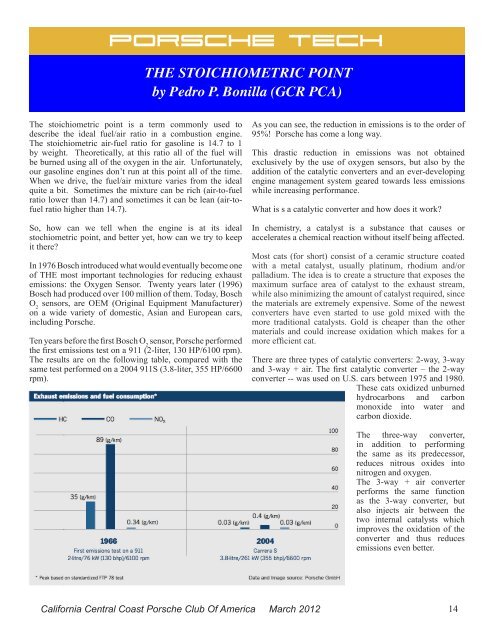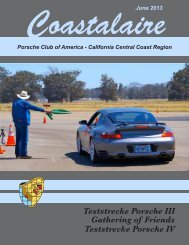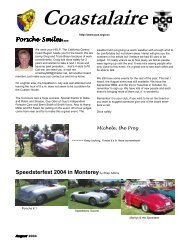Board Meetings - California Central Coast - Porsche Club of America
Board Meetings - California Central Coast - Porsche Club of America
Board Meetings - California Central Coast - Porsche Club of America
Create successful ePaper yourself
Turn your PDF publications into a flip-book with our unique Google optimized e-Paper software.
PORSCHE TECH<br />
The stoichiometric point is a term commonly used to<br />
describe the ideal fuel/air ratio in a combustion engine.<br />
The stoichiometric air-fuel ratio for gasoline is 14.7 to 1<br />
by weight. Theoretically, at this ratio all <strong>of</strong> the fuel will<br />
be burned using all <strong>of</strong> the oxygen in the air. Unfortunately,<br />
our gasoline engines don’t run at this point all <strong>of</strong> the time.<br />
When we drive, the fuel/air mixture varies from the ideal<br />
quite a bit. Sometimes the mixture can be rich (air-to-fuel<br />
ratio lower than 14.7) and sometimes it can be lean (air-t<strong>of</strong>uel<br />
ratio higher than 14.7).<br />
So, how can we tell when the engine is at its ideal<br />
stochiometric point, and better yet, how can we try to keep<br />
it there?<br />
In 1976 Bosch introduced what would eventually become one<br />
<strong>of</strong> THE most important technologies for reducing exhaust<br />
emissions: the Oxygen Sensor. Twenty years later (1996)<br />
Bosch had produced over 100 million <strong>of</strong> them. Today, Bosch<br />
O 2 sensors, are OEM (Original Equipment Manufacturer)<br />
on a wide variety <strong>of</strong> domestic, Asian and European cars,<br />
including <strong>Porsche</strong>.<br />
Ten years before the first Bosch O 2 sensor, <strong>Porsche</strong> performed<br />
the first emissions test on a 911 (2-liter, 130 HP/6100 rpm).<br />
The results are on the following table, compared with the<br />
same test performed on a 2004 911S (3.8-liter, 355 HP/6600<br />
rpm).<br />
INSERT: Table.jpg HERE<br />
THE STOICHIOMETRIC POINT<br />
by Pedro P. Bonilla (GCR PCA)<br />
<strong>California</strong> <strong>Central</strong> <strong>Coast</strong> <strong>Porsche</strong> <strong>Club</strong> Of <strong>America</strong> March 2012<br />
As you can see, the reduction in emissions is to the order <strong>of</strong><br />
95%! <strong>Porsche</strong> has come a long way.<br />
This drastic reduction in emissions was not obtained<br />
exclusively by the use <strong>of</strong> oxygen sensors, but also by the<br />
addition <strong>of</strong> the catalytic converters and an ever-developing<br />
engine management system geared towards less emissions<br />
while increasing performance.<br />
What is s a catalytic converter and how does it work?<br />
In chemistry, a catalyst is a substance that causes or<br />
accelerates a chemical reaction without itself being affected.<br />
Most cats (for short) consist <strong>of</strong> a ceramic structure coated<br />
with a metal catalyst, usually platinum, rhodium and/or<br />
palladium. The idea is to create a structure that exposes the<br />
maximum surface area <strong>of</strong> catalyst to the exhaust stream,<br />
while also minimizing the amount <strong>of</strong> catalyst required, since<br />
the materials are extremely expensive. Some <strong>of</strong> the newest<br />
converters have even started to use gold mixed with the<br />
more traditional catalysts. Gold is cheaper than the other<br />
materials and could increase oxidation which makes for a<br />
more efficient cat.<br />
There are three types <strong>of</strong> catalytic converters: 2-way, 3-way<br />
and 3-way + air. The first catalytic converter – the 2-way<br />
converter -- was used on U.S. cars between 1975 and 1980.<br />
These cats oxidized unburned<br />
hydrocarbons and carbon<br />
monoxide into water and<br />
carbon dioxide.<br />
The three-way converter,<br />
in addition to performing<br />
the same as its predecessor,<br />
reduces nitrous oxides into<br />
nitrogen and oxygen.<br />
The 3-way + air converter<br />
performs the same function<br />
as the 3-way converter, but<br />
also injects air between the<br />
two internal catalysts which<br />
improves the oxidation <strong>of</strong> the<br />
converter and thus reduces<br />
emissions even better.<br />
14

















